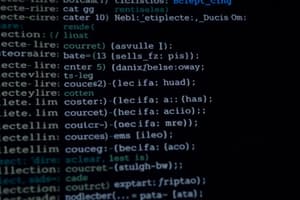Podcast
Questions and Answers
How is a sparse matrix typically represented in memory?
How is a sparse matrix typically represented in memory?
A sparse matrix can be represented using a linked list or an array of structures that store only non-zero elements along with their row and column indices.
List some applications of stacks.
List some applications of stacks.
Stacks are used in function call management, expression evaluation, and backtracking algorithms.
What is tail recursion, and how does it differ from normal recursion?
What is tail recursion, and how does it differ from normal recursion?
Tail recursion occurs when the recursive call is the last operation in the function, allowing for optimization by reusing stack frames, unlike normal recursion which may require maintaining multiple stack frames.
Define a full binary tree.
Define a full binary tree.
What is Dijkstra's algorithm used for?
What is Dijkstra's algorithm used for?
Flashcards
Sparse Matrix Representation
Sparse Matrix Representation
A method of storing a matrix in memory that only uses space for the non-zero elements, making it efficient for matrices with many zero values.
Stack Applications
Stack Applications
Stacks are useful in tasks like function calls, expression evaluation, and undo/redo operations.
Tail Recursion
Tail Recursion
A type of recursion where the recursive call is the very last operation in the function.
Full Binary Tree
Full Binary Tree
Signup and view all the flashcards
Dijkstra's Algorithm
Dijkstra's Algorithm
Signup and view all the flashcards
Study Notes
Section A
-
Sparse Matrix Representation: Describe how sparse matrices are stored in memory minimizing storage of zero values.
-
Stack Applications: List examples of where stacks are used.
-
Tail Recursion: Explain the concept of tail recursion.
-
Full Binary Tree Definition: Define a full binary tree.
-
Spanning Tree Definition: Define a spanning tree.
Section B
-
Data Structure Operations: Explain various data structure operations with a brief example.
-
Infix to Postfix Conversion Algorithm: Describe how to convert an infix expression to postfix using an algorithm.
-
Tower of Hanoi Problem: Describe the Tower of Hanoi problem and draw a recursion tree for three disks.
-
Queue Insertion Algorithm: Write an algorithm for inserting an element in the linked representation of a queue.
-
Circular Queues and their Disadvantage: Discuss the disadvantages of simple queues compared to circular queues. Detail a deletion algorithm for a circular queue.
-
Deletion Algorithm in Binary Search Tree: Describe how to delete an element from a binary search tree. Explain data structures and their types.
-
Hashing Definition: Define hashing.
-
Overflow Conditions for Circular Queue: Describe conditions where a circular queue overflows.
Section C
- Stack Push and Pop Operations (C Function): Write a C function for the push and pop operations on a stack.
Section C
-
Traversal Algorithm of Singly Linked List: Describe an algorithm for traversing a singly linked list.
-
Array Element Insertion: Explain how an element is inserted at the beginning of a one-dimensional array.
-
Abstraction Data Type examples: Explain abstract data types with examples.
-
Bubble Sort Algorithm(C): Write a C program illustrating the bubble sort.
-
Polynomial Addition using Linked Lists Algorithm: Describe how two polynomial equations are added using linked lists.
-
AVL Trees and Rotations: Explain AVL trees including details of all rotations with appropriate examples.
Section C Question 6
- Dijkstra's Algorithm: Explain Dijkstra's algorithm with suitable examples.
Additional Questions
-
Binary Tree Construction: Construct a binary tree given preorder and inorder traversals. Show the preorder and inorder traversals steps.
-
Depth First Search (DFS): Explain the depth-first search algorithm with a suitable example.
Studying That Suits You
Use AI to generate personalized quizzes and flashcards to suit your learning preferences.




